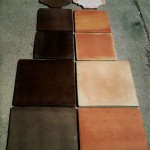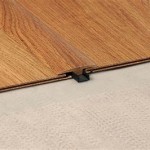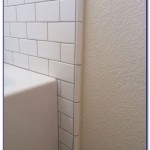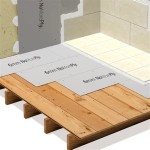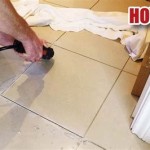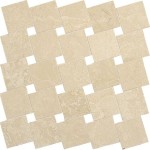Can You Nail Into Asbestos Tile? Understanding the Risks and Alternatives
The question of whether or not to nail into asbestos tile is a complex one, heavily laden with potential health risks. Asbestos, once a widely used building material due to its fire-resistant and insulating properties, is now known to be a hazardous substance. Disturbing asbestos-containing materials (ACMs), such as asbestos floor tiles, can release microscopic fibers into the air, posing a significant danger to human health. Therefore, understanding the risks and exploring safer alternatives is paramount.
Asbestos floor tiles were commonly installed in homes and commercial buildings from the 1920s until the 1980s. These tiles are typically 9x9 or 12x12 inches and contain chrysotile asbestos, also known as white asbestos, bound within a vinyl or asphalt matrix. This encapsulation initially reduces the risk of fiber release during normal conditions. However, any activity that damages or degrades the tile, including nailing, sawing, sanding, or even aggressive scraping, can liberate these dangerous fibers.
Before undertaking any work on or near suspected asbestos-containing materials, it is crucial to determine the presence of asbestos through professional testing. A qualified asbestos inspector can collect samples of the tile and have them analyzed in a laboratory. This will definitively confirm whether the material contains asbestos and inform subsequent actions.
The Dangers of Disturbing Asbestos
The primary concern with nailing into asbestos tile, or any activity that disturbs ACMs, is the release of asbestos fibers into the air. These fibers, when inhaled, can become lodged in the lungs, leading to a range of serious health problems, including:
Asbestosis: A chronic and progressive lung disease characterized by scarring of the lung tissue. This scarring leads to shortness of breath, coughing, and fatigue. Asbestosis is irreversible and can significantly impact quality of life.
Lung Cancer: Asbestos exposure is a known risk factor for lung cancer, particularly in individuals who also smoke. The synergistic effect of asbestos and smoking dramatically increases the likelihood of developing lung cancer.
Mesothelioma: A rare and aggressive cancer that affects the lining of the lungs, abdomen, or heart. Mesothelioma is almost exclusively caused by asbestos exposure and has a poor prognosis.
The risk of developing these diseases increases with the amount and duration of asbestos exposure. Even short-term exposure can pose a risk, especially if the concentration of airborne fibers is high. Children are particularly vulnerable to the effects of asbestos, as their developing lungs are more susceptible to damage. Furthermore, the latency period between asbestos exposure and the onset of disease can be decades, making it challenging to directly link illness to past exposure.
Why Nailing Into Asbestos Tile is Problematic
The act of nailing directly into asbestos tile presents several problems. Firstly, the impact of the nail can fracture the tile, releasing asbestos fibers into the surrounding air. The degree of fiber release depends on several factors, including the condition of the tile, the force of the impact, and the efficiency of any dust control measures employed. Even if the tiles appear intact, microscopic cracks and fissures may exist, providing pathways for fiber release.
Secondly, the nail itself can become contaminated with asbestos fibers. Removing or relocating the nail later can further disperse these fibers. The contaminated nail then becomes a source of potential secondary exposure, as anyone who handles it could inadvertently inhale or ingest asbestos fibers.
Thirdly, the surrounding area can become contaminated with asbestos dust. The dust generated during the nailing process can settle on surfaces, such as floors, walls, and furniture. This contaminated dust can then be re-suspended into the air through normal activities, such as sweeping, dusting, or even walking. Proper cleanup procedures are crucial to prevent the spread of contamination.
Finally, attempting to repair or conceal the nail hole with patching compounds or other materials can further disturb the asbestos tile and increase the risk of fiber release. The act of sanding or scraping the patch can generate significant amounts of asbestos dust.
Alternatives to Nailing Into Asbestos Tile
If it is determined that the floor tiles contain asbestos, nailing into them is strongly discouraged. Safer alternatives should be explored to minimize the risk of asbestos exposure.
Encapsulation: Encapsulation involves covering the existing asbestos tile with a new layer of flooring, such as vinyl plank, laminate, or carpet. This creates a barrier that prevents the release of asbestos fibers. Before encapsulation, it is essential to ensure that the existing tile is in good condition and securely adhered to the subfloor. Loose or damaged tiles should be repaired or removed by a qualified asbestos abatement professional before encapsulation. Furthermore, the new flooring material should be installed in a way that does not disturb the asbestos tile, such as using adhesives specifically designed for this purpose.
Professional Asbestos Abatement: The safest option is to have the asbestos tile professionally removed by a licensed asbestos abatement contractor. These contractors have the training, equipment, and expertise to safely remove and dispose of asbestos-containing materials in accordance with federal, state, and local regulations. Abatement involves creating a containment area to prevent the spread of asbestos fibers, using specialized equipment such as HEPA vacuums and respirators, and properly disposing of the asbestos waste at an approved landfill.
Adhesive Alternatives: If you need to attach something to the floor near the tiles, consider using strong adhesives or construction adhesives that are specifically designed for bonding to flooring materials. These adhesives can provide a secure hold without the need for nails or screws. It is crucial to select an adhesive that is compatible with the existing flooring and the item being attached.
Relocation of Attachments: Consider whether the item being attached can be relocated to a different area where asbestos tile is not present. This eliminates the need to disturb the asbestos-containing material altogether.
Non-Penetrating Fasteners: Depending on the application, there might be non-penetrating fasteners available that can adhere to the floor surface without requiring any nailing or screwing. These fasteners typically use strong adhesives or mechanical grips to provide a secure hold.
Before choosing any alternative, it is crucial to carefully assess the situation and consider the potential risks. Consult with a qualified asbestos professional to determine the most appropriate course of action. Always prioritize safety and follow all applicable regulations to minimize the risk of asbestos exposure.
In situations where encapsulation is chosen, regular inspections of the new flooring are necessary to identify any signs of damage or wear. If the encapsulated asbestos tile becomes exposed, prompt action should be taken to repair the damage and prevent further fiber release. Similarly, if asbestos abatement is performed, ensure that the contractor provides documentation confirming that the work was completed in accordance with regulations and that the area is safe for re-occupancy.
Proper disposal of asbestos-containing materials is critical to prevent future exposure. Asbestos waste must be disposed of at specially designated landfills that are equipped to handle hazardous materials. Never dispose of asbestos waste in regular trash or recycling bins. Contact your local environmental agency for information on approved asbestos disposal sites in your area.

Asbestos Tile What Did You Do With Yours

Let S Play A Game Called Are These Asbestos Tiles That I Just Removed Addicted 2 Decorating

3 Ways To Identify Asbestos Tiles Wikihow

Asbestos Floor Tiles And Containing Sheet Flooring Vintec

3 Ways To Identify Asbestos Tiles Wikihow

Asbestos Tile Doityourself Com Community Forums

Asbestos Tiles In Basement Doityourself Com Community Forums

Asbestos Floor Tiles 101 What To Know About This Old Home Hazard Bob Vila

Asbestos Floor Tile Is It Safe To Remove On Your Own
Assuming Asbestos Tile Diy Home Improvement Forum
Related Posts


